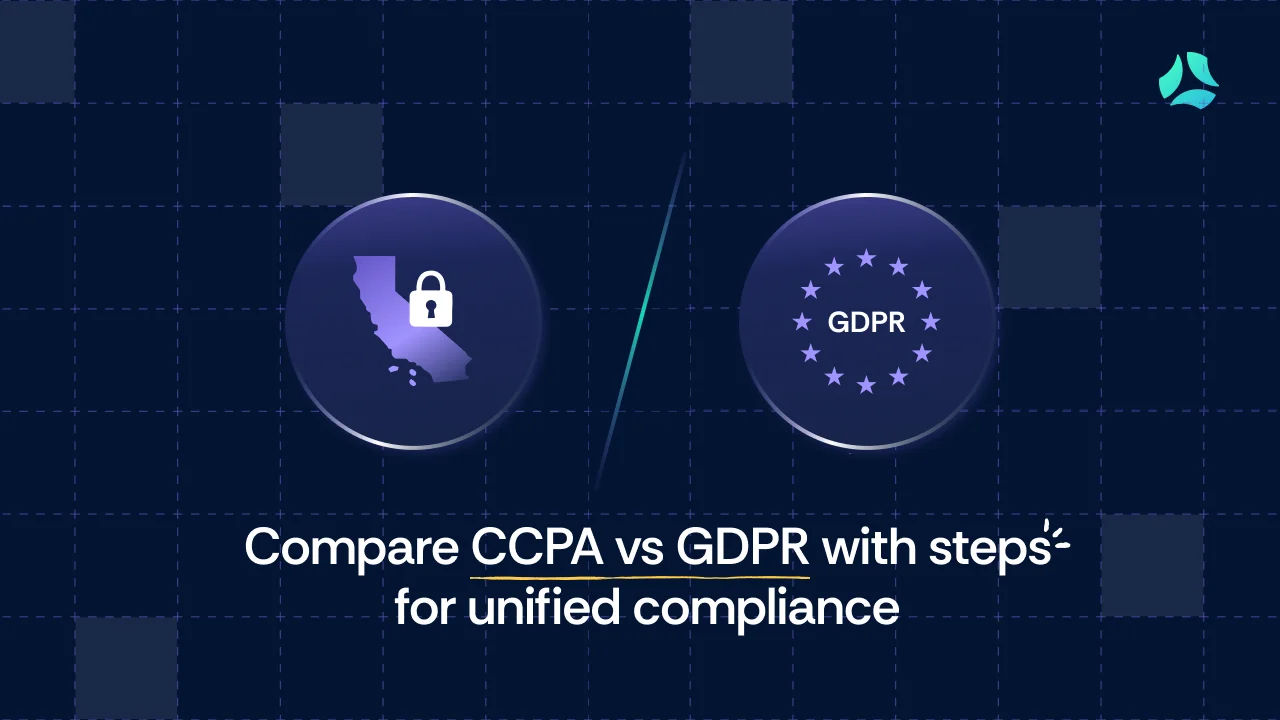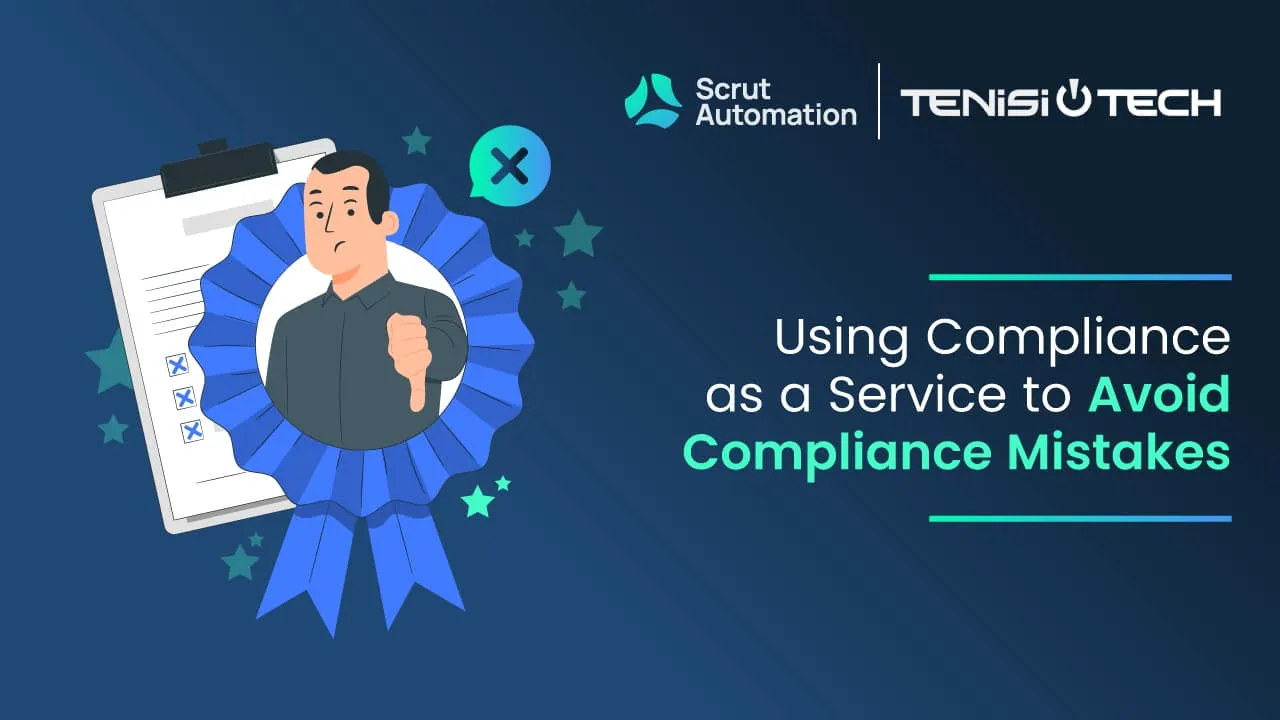Compare CCPA vs GDPR with steps for unified compliance

Digital data isn’t just code anymore. It’s a business risk or a growth driver, depending on how you handle it. As personal data volumes explode, staying compliant with evolving privacy laws has become harder than ever.
As regulations evolve, two major laws dominate the landscape: the California Consumer Privacy Act (CCPA) and the General Data Protection Regulation (GDPR). While both aim to strengthen data rights, their scope, obligations, and enforcement mechanisms differ in critical ways.
Miss a detail, and you could face costly fines, loss of customer trust, and operational delays. But align your compliance programs effectively, and you unlock faster audits, smoother expansion into new markets, and stronger data governance.
In this guide, we break down key CCPA vs GDPR similarities and differences and offer actionable insights to comply with both regulations with minimal effort.
[Note: For the purposes of this guide, all references to the CCPA include the amendments made by the California Privacy Rights Act (CPRA), which is the version of the law applicable in 2025.]
What is GDPR?
GDPR is a landmark EU law focused on protecting EU residents’ right to data privacy. It provides a unified framework for organizations that collect, process, store, or share data about EU residents. At its core, GDPR shifts the balance of power back to the individual, making transparency, consent, and accountability non-negotiable.
What counts as personal data under GDPR?
GDPR defines personal data broadly. It is any information that relates to an identified or identifiable natural person (the “data subject”). This includes obvious identifiers, such as names, addresses, phone numbers, and ID numbers, as well as digital identifiers, including IP addresses, cookie data, and location data. Even data held by hospitals, schools, or employers that can be linked to a specific individual is considered personal data.
The GDPR also designates certain types of information as special category data, which are subject to stricter protections. These include data revealing racial or ethnic origin, political opinions, religious or philosophical beliefs, trade union membership, genetic and biometric data (when used for identification), health data, and data concerning a person’s sex life or sexual orientation. Processing such data generally requires explicit consent or a specific legal basis.
The core principles of GDPR
The GDPR is a comprehensive set of rules designed to give data subjects more control over their personal data. It is built on seven key principles, which act as a framework for data protection and privacy, ensuring that personal data is handled responsibly and securely. Here’s what you must do to adhere to these principles:
- Lawfulness, fairness, and transparency: Process personal data of EEA individuals lawfully, fairly, and with full transparency.
- Purpose limitation: Only collect data for specific, explicit, and legitimate purposes.
- Data minimization: Only collect and process the smallest amount of data necessary to achieve your specified purpose.
- Accuracy: Ensure personal data is accurate and up to date, with every reasonable step taken to rectify inaccuracies.
- Storage limitation: Retain personal data only for as long as needed and delete or anonymize it once your processing purpose is fulfilled.
- Integrity and confidentiality: Ensure you have adequate security measures in place to protect data from unlawful processing, unauthorized access, and accidental loss or damage.
- Accountability: Establish appropriate policies and procedures as well as maintain up-to-date records to prove that you are in full compliance with the data processing principles.

Who needs to comply with the GDPR?
Still unsure if GDPR applies to your business? Here’s the answer:
GDPR applies to data controllers and data processors that handle the personal data of individuals in the European Economic Area (EEA), regardless of where the organization is located. It also applies to non-EEA organizations if they offer goods or services to individuals in the EEA or monitor their behavior (e.g., tracking, profiling).
It doesn’t matter where your company is headquartered. If your users, customers, or employees include anyone located in the EU, you’re on the hook.
Even something as simple as collecting emails for order confirmations or phone numbers for marketing triggers GDPR obligations.
Data subjects’ rights and enforcement
The GDPR grants individuals in the EEA EU (data subjects) a range of rights concerning their data. Those rights are:
- Right to be informed.
- Right of access.
- Right to rectification.
- Right to erasure (or right to be forgotten).
- Right to restrict processing.
- Right to data portability.
- Right to object.
- Rights related to automated decision-making, including profiling.
Now, the question is: “Who enforces these rights and how?”
Under GDPR, national data protection authorities (DPAs) enforce data subject rights and handle complaints. Each country in the EEA has its own independent DPA, for example, the Data Protection Commissioner in Ireland and Datatilsynet in Denmark. These regulators investigate complaints, conduct audits of businesses, and issue penalties.
At the EU level, the European Data Protection Board (EDPB) coordinates enforcement and ensures consistency across member states.
DPAs have a range of powers, including:
- Conducting investigations.
- Issuing warnings.
- Banning unlawful processing.
- Imposing fines of up to €20 million or 4% of global annual revenue, whichever is higher.
If someone believes their data rights were violated, they can file a complaint directly with the relevant DPA.
What is CCPA/CPRA?
CCPA is a California (US) statutory law that took effect in January 2020. It grants California residents enhanced privacy rights over how their personal information is collected, used, and shared. If your business violates these rules, you could face enforcement actions and penalties.
The California Privacy Rights Act (CPRA), effective from January 1, 2023, builds on the CCPA. It expands privacy protections by:
- Introducing new consumer rights.
- Strengthening existing rights.
- Covering sensitive personal information.
- Establishing a new regulator: the California Privacy Protection Agency (CPPA).
- Extending protections to employees (previously excluded).
Important: The CPRA doesn’t replace the CCPA; it amends and refines the existing law. That means you must still comply with both the original and updated provisions.
Who needs to comply with the CCPA?
The CCPA applies to any for-profit organization that collects personal information from California residents and meets one or more of the following criteria:
- Has over $25 million of gross annual revenue.
- Buys, sells, or shares the personal data of 100,000 or more California residents or households (raised from 50,000 by the CPRA).
- Draws at least 50% of its annual revenue from selling the personal information of California residents.
Not based in California? You’re not off the hook.
If you handle personal data of California residents regardless of where you’re located, the CCPA still applies.
Additionally, CCPA-granted rights apply only to natural persons residing in California, even if they’re temporarily out of state.
Privacy rights under CCPA/CPRA and enforcement
Together, the CCPA and CPRA provide consumers with the following rights:
- Right to know (what data is collected and shared).
- Right to delete personal data.
- Right to opt out of data sale or sharing.
- Right to non-discrimination.
- Right to correct inaccurate personal information (new in CPRA).
- Right to limit the use and disclosure of sensitive personal information (new in CPRA).
Who enforces these rights and how?
The California Attorney General (CA AG) and the CPPA can enforce these rights. The CCPA has the authority to develop rules, investigate violations, conduct hearings, and levy fines. The AG can bring direct civil enforcement actions, such as lawsuits, and even initiate legal actions on behalf of consumers. The penalties can go up to:
- $2,663 per unintentional violation.
- $7,988 per intentional violation or for violating minors’ rights.
These fine amounts came into effect on January 1, 2025, as the CPPA adjusted the original amounts ($2,500 and $7,500) to reflect the increases to the Consumer Price Index (CPI).
CCPA vs GDPR: Know the differences
Many teams assume CCPA and GDPR are interchangeable. They’re not. While they share foundational principles such as user privacy and transparency, their scopes, requirements, and enforcement mechanisms differ, sometimes significantly.
If you're compliant with one, it doesn't mean you're covered under the other. Here's a quick side-by-side comparison to help you align with both:
Key similarities: GDPR vs CCPA
Despite their differences, the GDPR and the CCPA/CPRA share a core mission: protecting individual privacy and putting people in control of their data.
Here’s where they align, and why it matters for your compliance strategy:
1. Empower individuals with data rights
Both laws are built around a simple idea: your users should control their own data.
Whether it’s the right to access, correct, or delete personal information, GDPR and CCPA/CPRA give individuals clear, enforceable rights. The regulations also provide additional rights related to data use and disclosure.
These aren’t just legal checkboxes. They’re a foundation for user trust. If someone wants to manage or erase their digital footprint, your systems need to be ready.
2. Require transparency in data usage
Both the GDPR and CCPA/CPRA require businesses to be transparent about their data practices. Beyond just collecting data, you must clearly inform individuals how your business handles their personal information, from collection to deletion.
This means you must provide easily accessible information, typically through a comprehensive privacy policy. You can use conventional or electronic means to publish the policy. The policy must detail what data is collected, why, who can access it, and how long it’s kept. This must be easy to find, easy to read, and written in plain language. If your audience includes minors or you're collecting sensitive data, clarity becomes non-negotiable.
3. Demand strong data security and breach notifications
Both the CCPA and GDPR require you to implement adequate data security measures. This means you must implement security controls (e.g., data encryption, access controls) to protect sensitive information from unauthorized access, exposure, and theft.
Although the timelines and thresholds differ, both privacy laws require you to notify the relevant authorities and affected individuals of data breaches within a specific timeframe.
4. Carry heavy consequences for non-compliance
Regulators take privacy seriously, and so should you.
Failing to comply with the GDPR or CCPA doesn’t just lead to legal penalties (which can be steep). It opens the door to civil lawsuits, operational restrictions, and enforcement actions that can disrupt your business overnight.
But the ripple effects often run deeper.
Reputational damage, loss of customer trust, and slower growth are harder to quantify but harder to recover from, too.
For early-stage companies and SMEs, the impact can be existential. One recent study found that compliance issues contribute to nearly 75% of fintech startup failures within the first three years.
Major differences between CCPA and GDPR
While the CCPA and GDPR have a common goal, they are distinct laws. Each has its own definitions and specific compliance requirements. The differences stand out in the answers to the following questions:
- How does each law apply to your business? Who is protected?
- What are the data collection and processing requirements of each law?
- How can you comply with each law when selling or transferring data to third parties?
- Do you need to justify how you process data under each law?
That’s what you must focus on when deciding how to comply with one or both. A lapse in understanding could cost you dearly.
Let’s break down the key differences in simple terms:
CCPA vs GDPR: scope
GDPR: Applies to any organization—regardless of location—that processes personal data of individuals in the EEA. If you offer goods or services to the EU or track user behavior there, GDPR applies to you.
CCPA: Applies to for-profit businesses globally that collect personal information from California residents, households, or devices, provided they meet one or more of the annual revenue, user volume, and data sale percentage thresholds.
What does this mean for your business
GDPR’s scope is much broader. If you’re a U.S.-based e-commerce company shipping to the EU/EEA, or a Japanese app with users in France, you’re in scope. Often, this means implementing GDPR-grade practices across your global operations because running two systems (EEA-compliant and non-EEA) can be costly and inconsistent.
In contrast, CCPA’s reach is narrower. Unless you’re targeting California residents at scale, its impact on your operations may be limited.
CCPA vs GDPR: consent requirement
GDPR: Primarily uses an opt-in model, which means you must obtain explicit consent from users before collecting or processing their data. You need clear, unambiguous consent (no pre-ticked boxes) and must explain exactly how the data will be used.
CCPA: Primarily employs the opt-out model, which means the default consent is “yes”. Users can later request that you stop selling or sharing their data, and you’re legally obligated to comply.
What does this mean for your business
With GDPR, you’ll collect less data up front but earn greater user trust by being transparent from the start.
With CCPA, you can collect more by default, but you need to make opt-outs easy. This means adding features like a prominent “Do Not Sell or Share My Personal Information” link and making sure opt-out requests are honored quickly and accurately.
CCPA vs GDPR: Sale of data definition
GDPR: Unlike CCPA, GDPR doesn’t explicitly define “sale of data”. Instead, it requires fairness and transparency for all data processing activities, including the transfer of data to third parties.
CCPA: Section 1798.140 of the CCPA defines it broadly to include any disclosure of personal information “to a third party for monetary or other valuable consideration.” The CPRA expanded this to include “sharing” the data.
What does this mean for your business?
GDPR requires you to disclose every data transfer, regardless of monetary exchange. This means you must clearly document every data flow, showing who receives the data and why.
For the CCPA, you must clearly identify your data transfers (including those not involving money) that constitute a sale or sharing of personal information. This involves understanding your targeted advertising and data monetization strategies, which, if misclassified, could lead to non-compliance.
CCPA vs GDPR: Legal basis for processing
GDPR: Besides being fair and transparent, you can only process personal data if you have a lawful reason to do so. GDPR specifies six legal bases for processing: consent, contract, legal obligation, vital interests, public task, and legitimate interest.
CCPA: The CCPA doesn’t specifically require businesses to have a legal basis for processing personal data, provided they honor users’ opt-out requests. Then again, there are exceptions, such as compliance with laws, cooperation with regulators, or research for internal or public interest.
What does this mean for your business
With the GDPR, you must adopt a reason-first approach to confirm the legal basis for processing personal data. This means you need to proactively implement rigorous internal policies, maintain detailed records, and conduct regular audits.
With CCPA, the focus shifts to user choice. You must build mechanisms to respect opt-outs and limit data processing accordingly. This means implementing robust consent management and data governance workflows.
How to align CCPA and GDPR compliance?
A common question businesses ask is: “Do I need to comply with CCPA, GDPR, or both?”
Closely followed by: “How can we avoid penalties?”
While there is nothing wrong with that, there is more to compliance than just applicability and preventing fines. Rather than just surviving, it’s about thriving.
Compliance with both has several strategic and business benefits, especially for fast-growing businesses expanding into new territories. It can help you:
- Reduce risks.
- Build greater stakeholder trust.
- Improve your brand reputation.
- Secure more enterprise clients.
Therefore, even if only one applies, you can comply with both laws and future-proof your business.
Although CCPA and GDPR have their differences, they aren’t mutually exclusive. Treating them as such means duplicated efforts, wasted time, and increased compliance debt.
Alternatively, finding a common ground can help you create an integrated compliance program. The synchronized effort enables you to efficiently satisfy both regulations, reducing repetitive work and freeing up valuable resources.
Here’s how you can implement a combined compliance program for both laws:
Create a unified privacy program
Focus on the core principles of both CCPA and GDPR. Find commonalities and develop an integrated approach that enables you to meet the requirements of both frameworks with minimal effort.
Here are the overlapping fundamental principles of both, which you can manage simultaneously:
- Data purpose and scope: Collect only absolutely essential data and clarify the processing purpose.
- Fair and open handling: Be transparent in your privacy policies, ensuring individuals understand how their data is collected, used, and protected.
- Individual rights: Uphold user rights and honor data subject requests.
- Strong data protection: Use robust data security measures to prevent unauthorized access and breaches. In the event of a breach, promptly notify the authorities and affected individuals.
- Accountability: Take clear ownership of data protection efforts and ensure you can demonstrate adherence to regulations when needed.
Map data to both frameworks
This is one of the most crucial steps where you identify, locate, and classify all the personal data your business collects and processes. Mapping the data enables you to understand its entire lifecycle—from collection and storage to usage, sharing, and eventual deletion—based on each law’s requirement.
By doing this, you can understand precisely how each data point falls under GDPR and CCPA requirements and process it accordingly. It also allows you to identify overlaps and gaps in your existing practices.
Centralize subject request management
Several requirements under the GDPR and CCPA regarding data subject requests (DSRs) overlap, with a few differences. By following the unified process below, you can streamline DSR management:
- Intake and tracking: Establish easily accessible channels for individuals to submit requests, and centralize all inquiries for efficient tracking and management.
- Identity verification: Implement strong automated mechanisms to confirm the requester’s identity.
- Response: Fulfill different requests within the specified time by using automation to identify all relevant data points.
- Record-keeping: Document all DSR activity (including timelines) centrally to maintain accountability and audit readiness.
Use customizable policies and automated consent management
Ensuring flawless compliance hinges on the effectiveness and currency of the privacy policies. Develop and implement a single, overarching policy that contains separate sections for each law’s specific requirements and that can be customized as required.
Leverage privacy management software to automate consent logging and tracking, sync user choices across devices, and scan for third-party trackers, enabling you to ensure compliance at every level.
How Scrut helps you stay compliant with CCPA and GDPR
Managing compliance across multiple regulations, especially something as nuanced as CCPA vs GDPR, can feel overwhelming, particularly for lean teams. But it doesn’t have to be.
Compliance automation platforms like Scrut, with multi-framework support, can significantly reduce your compliance efforts.
With its wide range of automation features, Scrut can streamline your CCPA and GDPR compliance processes. Here’s how Scrut helps:
- Pre-mapped frameworks for CCPA and GDPR: Kick-start your unified compliance program with Scrut’s built-in requirements, controls, and processes for both CCPA and GDPR. No more time-consuming, duplicated efforts for manual mapping and interpretation of compliance guidelines.
- Automated monitoring and alerts: Identify compliance gaps quickly using Scrut’s daily control monitoring feature, with automated alerts and notifications, so you know exactly what needs fixing and who owns it.
- Consent collection and RoPA tools for GDPR compliance: Automatically manage consent collection and maintain a detailed Record of Processing Activities (RoPA) with Scrut’s platform.
- Privacy policy templates for both the EU and California requirements: Create and customize region-specific policies using Scrut’s built-in editor. Comply with EU and California mandates without starting from scratch.
- Centralized dashboard for subject request tracking: Easily manage, track, and respond to data subject access requests (DSARs) from a single, unified dashboard. This ensures you meet strict response deadlines for both CCPA and GDPR.
Plus, you gain access to Scrut’s team of compliance experts with extensive experience across several standards and regulations. They guide you through setup, audits, and scale, every step of the way.
Looking to align your CCPA vs GDPR compliance without the heavy lift? Schedule a demo and see how Scrut unifies CCPA and GDPR compliance in a single platform.
Frequently asked questions
1. Does our business need to comply with both GDPR and CCPA?
Whether you need to comply with both depends on your business’s operations. If your company processes the personal data of both California residents and individuals in the EEA, as well as meets the CCPA criteria for businesses, then both laws apply to your data processing operations. Many fast-growing companies choose to align with both regulations to future-proof their operations, build customer trust, and facilitate expansion into new markets.
2. What is a DPO, and do we need one for CCPA compliance?
A Data Protection Officer (DPO) is an expert who is responsible for advising on and monitoring GDPR compliance within an organization. GDPR mandates a DPO for companies that process large-scale special category data or engage in systematic monitoring. In contrast, the CCPA does not require a DPO.
3. What are the biggest risks of non-compliance for fast-growing companies?
Beyond steep monetary fines, non-compliance can lead to severe business risks. Failing to adhere to these laws can result in costly lawsuits, operational disruptions, and significant reputational damage. For early-stage companies and SMEs, non-compliance can be an existential threat, as it erodes customer trust and can block your company from securing new enterprise clients.



.webp)














